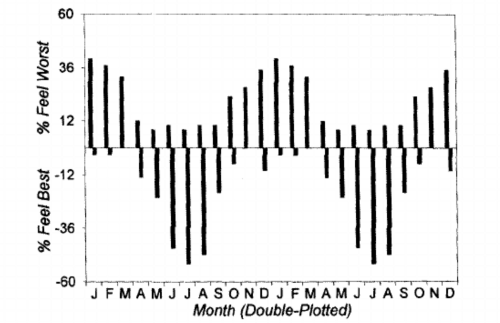
Why We Are More Likely to Seek Online Therapy in the Winter
Why We Are More Likely to Seek Online Therapy in the Winter
We’ve had a look at some research on seasonality in psychiatric disorders and patterns in therapy seeking.

As we head into the more winter months, here at Kara the summer break is in the rear-view mirror. We’re getting ready to use the heavier coats, and warmer layers, as we prepare to settle in for the winter. For some, this is a time of new beginnings, cozy afternoons indoors and quality time with family. But for many, the winter can be a difficult time.
Our mental health suffers during the colder, darker months.
Studies have indicated that 95% of individuals report experiencing some degree of mood fluctuations across seasons, and an estimated 10–20% of all mood disorders have seasonal patterns (Bartko & Kasper., 1989; Magnusson, 2000). Perhaps the most well-known contributor to dips in mental health in the winter is Seasonal Affective Disorder (SAD). Typically occurring in winter, SAD involves recurrent depressive epsiodes of mild-moderate severity which can lead to impaired functioning in everyday life (Partonen & Lönnqvist, 1998). SAD is more common in the northern latitudes, and in Iceland the prevalence of SAD is estimated at 3.8% of the population (Magnússon & Stefánsson, 1993). A study by Gardarsdottir et al (2010) found a 5–35% increase in patients initiating antidepressant use during the winter than in the summer.
Other disorders have shown evidence of seasonality as well. A systematic review of seasonality of symptoms in Bipolar Disorder found seasonal peaks worldwide. Depressive episodes peak in early winter, and manic episodes during spring and summer. They found greater seasonal fluctuations in mood and behaviour of bipolar individuals than those with unipolar depression (Geoffroy et al., 2013).
One study found that patients with the eating disorder Bulimia Nervosa had marked seasonal patterns in symptoms, with 35% showing worsening symptoms and 28% of the participants meeting the criteria for a winter SAD diagnosis (Lam et al., 1996). The figures below describe the changes in mood and binge/purge behaviours by month.

Months in which BN patients binge/purge most/least(Lam et al., 1996).
It’s harder to access in-person treatment in the winter
We can see that research indicates that mental health in various forms can worsen during the winter months, however, this comes with its challenges. The effort of leaving the house in the dark and coming home in the dark, combined with the gloomy conditions can be an enormous mental effort for many and impossible for some. In countries such as Iceland, weather can get extreme during the winter, making travelling even short distances difficult. Even in good conditions, many live in rural areas where the nearest specialist can be up to 10 hours away by car. Adding on travel costs to treatment, that can potentially itself be costly, results in therapy being inaccessible for many, even without considering factors such as childcare, time off work and general health.
Online therapy could solve this problem
Being able to access treatment from the comfort of one’s home, or close to it, can make a world of difference during the winter months, when travel is impossible, difficult or simply too costly. Patients are safer, more secure and have more time, as they don’t need to travel between appointments. This can accommodate for stricter schedules during the winter time due to work or family commitments. Research has also shown that remote therapy can be equally effective as in-person treatment: See our blog about the effectiveness of online Cognitive Behavioural Therapy here.
When are we most likely to seek help?
A 2013 study found that people are more likely to seek information about mental illnesses and problems during the wintertime, reporting a 14% increase in Google searches for all major mental illnesses during the winter (Ayers et al, 2013).
More recently, Tirel et al. (2020) performed a study analysing when people are most likely to seek online therapy, and found that most first-time contacts are initiated during the winter and autumn months, accounting for 59% of initial contact with a professional. They also found that people were more likely to seek therapy in the afternoons and evenings during the week, and earlier in the day on weekends.
What does this mean for the specialist?
For professionals thinking about the next steps for your practice, these points are worth considering. If the majority of your clients are at school or work during the day, working the occasional weekend, or working during the evening a few times a week could also be a great way to accommodate your clients needs and widen your client base. If you’re offering therapy during the winter months, offering an online option to your clients through remote meetings could help to reduce cancellations due to travel restrictions and other commitments while saving on costs for both you and the client (See our blog on how telehealth is reducing costs in healthcare here).
References:
Ayers, J. W., Althouse, B. M., Allem, J.-P., Rosenquist, J. N., & Ford, D. E. (2013). Seasonality in Seeking Mental Health Information on Google. American Journal of Preventive Medicine, 44(5), 520–525. https://doi.org/10.1016/j.amepre.2013.01.012
Bartko, J. J., & Kasper, S. (1989). Seasonal changes in mood and behavior: A cluster analytic approach. Psychiatry Research, 28(2), 227–239. https://doi.org/10.1016/0165-1781(89)90049-8
Gardarsdottir, H., Egberts, T. C. G., van Dijk, L., & Heerdink, E. R. (2010a). Seasonal patterns of initiating antidepressant therapy in general practice in the Netherlands during 2002–2007. Journal of Affective Disorders, 122(3), 208–212. https://doi.org/10.1016/j.jad.2009.06.033
Gardarsdottir, H., Egberts, T. C. G., van Dijk, L., & Heerdink, E. R. (2010b). Seasonal patterns of initiating antidepressant therapy in general practice in the Netherlands during 2002–2007. Journal of Affective Disorders, 122(3), 208–212. https://doi.org/10.1016/j.jad.2009.06.033
Geoffroy, P. A., Bellivier, F., Scott, J., & Etain, B. (2014). Seasonality and bipolar disorder: A systematic review, from admission rates to seasonality of symptoms. Journal of Affective Disorders, 168, 210–223. https://doi.org/10.1016/j.jad.2014.07.002
Lam, R. W., Goldner, E. M., & Grewal, A. (1996). Seasonality of symptoms in anorexia and bulimia nervosa. International Journal of Eating Disorders, 19(1), 35–44. https://doi.org/10.1002/(SICI)1098-108X(199601)19:1<35::AID-EAT5>3.0.CO;2-X
Magnússon, A., & Stefánsson, J. G. (1993). Prevalence of Seasonal Affective Disorder in Iceland. Archives of General Psychiatry, 50(12), 941–946. https://doi.org/10.1001/archpsyc.1993.01820240025002
Molin, J., Mellerup, E., Bolwig, T., Scheike, T., & Dam, H. (1996). The influence of climate on development of winter depression. Journal of Affective Disorders, 37(2), 151–155. https://doi.org/10.1016/0165-0327(95)00090-9
Partonen, T., & Lönnqvist, J. (1998). Seasonal Affective Disorder. CNS Drugs, 9(3), 203–212. https://doi.org/10.2165/00023210-199809030-00004
Tirel, M., Rozgonjuk, D., Purre, M., & Elhai, J. D. (2020). When Do People Seek Internet Counseling? Exploring the Temporal Patterns of Initial Submissions to Online Counseling Services. Journal of Technology in Human Services, 38(2), 184–202. https://doi.org/10.1080/15228835.2018.1561348






